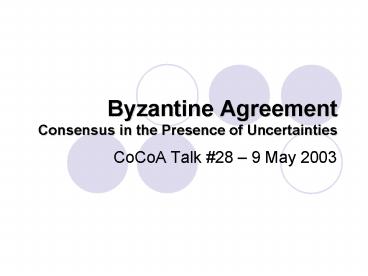Byzantine Agreement Consensus in the Presence of Uncertainties - PowerPoint PPT Presentation
1 / 25
Title:
Byzantine Agreement Consensus in the Presence of Uncertainties
Description:
But...they can only affect the system components over which they are supposed to ... graph G, tolerating f faults, if and only if the following conditions hold: ... – PowerPoint PPT presentation
Number of Views:103
Avg rating:3.0/5.0
Title: Byzantine Agreement Consensus in the Presence of Uncertainties
1
Byzantine AgreementConsensus in the Presence of
Uncertainties
- CoCoA Talk 28 9 May 2003
2
The Consensus/Agreement Problem
- Each process in the network begins with an
initial value and is supposed to output a value
of the same type. - All processes must agree outputs must be the
same even though the inputs can be arbitrary. - The problem arises in many distributed computing
applications, e.g processes attempting to reach
agreement, or identifying a component as faulty.
3
Lets attack!
Lets retreat!
4
Byzantine Agreement Problem
- Process might exhibit arbitrary behavior.
- Butthey can only affect the system components
over which they are supposed to have control - Sample problem
5
We take all this for granted
- The network is an n-node connected undirected
graph with processes 1,,n, where each process
knows the entire graph. - Every message that is sent is delivered
correctly. - The receiver of a message knows who sent it.
- There can be at most f failures.
6
Correctness Conditions
- AgreementNo two processes decide on different
values. - ValidityIf all processes start with the same
initial value v ? V then v is the only possible
decision value. - TerminationAll processes eventually decide.
7
Conditions in the presence of failures
- AgreementNo two non-faulty processes decide on
different values. - ValidityIf all non-faulty processes start with
the same initial value v ? V then v is the only
possible decision value for a non-faulty
process. - TerminationAll non-faulty processes eventually
decide.
8
attack
attack
attack
retreat
he said retreat
he said retreat
9
Impossibility Result
0
0
1
0
1
1
10
a
a1
11
a2
a
12
0
a
1
a3
13
Byzantine Agreement in General Graphs
- Condition for complete graphs
- Byzantine agreement in a tree?
- ConnectivityThe connectivity of a graph G,
conn(G), is defined to be the minimum number of
nodes whose removal results in either a
disconnected graph or a trivial 1-node graph.
14
Connectivity
- c-connectivityA graph G is said to be
c-connected if conn(G) c. - Mengers Theorem A graph is c-connected if and
only if every pair of nodes in G is connected by
at least c node-disjoint paths.
15
- The Byzantine agreement problem can be solved in
an n-node network graph G, tolerating f faults,
if and only if the following conditions hold - n gt 3f
- conn(G) gt 2f
16
1
2
4
3
17
3
4
1
2
4
2
3
1
18
0
0
0
19
1
1
1
20
1
0
0
21
Exponential Information Gathering
22
Algorithm EIGByz
- Round 1 Process i broadcasts val(l) to all
processes, including i itself. Then process i
records the incoming information. - 1. If a message with value v ? V arrives at i
from j, then i sets its val(j) to v - If no message with a value in V arrives from i to
j, then i sets val(j) to null. - Round k, 2 k f 1Process i broadcasts all
pairs (x,v) and processes the incoming
information. - If xj is a level k node label in T, where x is a
string of process indices and j is a single
index, and a message saying that val(x) v ? V
arrives at I from j, then I sets val(xj) to v. - If xj is a level k node label and no message with
a value in V for val(x) arrives at I from j, then
I sets val(xj) to null.
23
EIGByz continued
- At the end of f1 rounds, process i adjusts its
val assignment so that any null value is replaced
by the default v0 - Process i works from the leaves up decorating
each node with an additional newval. - For each leaf labeled x, newval(x) val(x). For
each non-leaf node labeled x, newval(x) is
defined to be the newval held by a strict
majority of the children node of x. - Process is final decision is newval(l)
24
Invariant Assertions
- Lemma 1 After f1 rounds of the EIGByz
algorithm, the following holds. If i,j, and k are
all nonfaulty processes, with i?j, then val(x)i
val(x)j for every label x ending in k - All nonfaulty processes agree on the value
relayed directly form nonfaulty processes.
25
- Lemma 2 After f1 rounds of the EIGByz
algorithm, the following holds. Suppose that x is
a label ending with the index of a nonfaulty
process. Then there is a value v ?V such that
val(x)i newval(x)i v for all nonfaulty
processes i. - All nonfaulty processes agree on the newvals
computed for nodes whose labels end with
nonfaulty process indices

